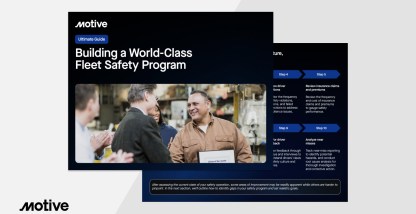- A roadside emergency kit can get you back on the road sooner
- Every vehicle driver can benefit from following a basic emergency road kit checklist
- Truckers have to add certain items, especially for DOT compliance
- A roadside kit is only one step in driver safety for commercial fleets
When it comes to commercial fleet safety on the road, a well-equipped roadside emergency kit is critical. This article will examine what you should pack in a roadside kit and share other ways to ensure driver safety on the road.
What is a roadside emergency kit?
A roadside emergency kit can make the difference between life or death in a road accident. Of course, that’s the extreme end of the spectrum, but even if you’re simply stuck on the side of a dark road in the middle of the night, you can find comfort in having a roadside safety kit.
A roadside tool kit helps you prepare for emergencies. Conditions on the road can change in an instant. Being prepared for accidents, poor conditions, or breakdowns can help drivers stay calm and collected on the road or pulled over safely to the side if the worst does happen.
Many vehicle manufacturers now offer roadside assistance programs. A driver might also pay for a motor club membership that provides roadside support. However, that requires a cell phone signal and an inevitable wait for someone to reach you to help. With a roadside emergency kit available, drivers may be able to get back on the road more quickly.
What should you have in a roadside assistance kit?
It’s a good idea for drivers of any type of vehicle to have an emergency road kit with them. Whether commuting or going long distances, drivers can gain confidence on the road knowing that they have a few basic items along for the ride.
The basic roadside assistance kit should include:
- Jumper cables or a portable lithium ion battery to keep a vehicle charged.
- Emergency flares to alert other drivers of a vehicle that’s pulled over ahead.
- Motor oil. Even a quart is enough to ensure the engine has enough lubrication for the vehicle to be operated safely.
- Coolant. In the event of a coolant leak, you’ll want to top up the antifreeze to prevent the engine from overheating on the way to the service station.
- First aid kit. Include a blanket or space blanket, flashlight, and extra batteries as well as bottled water, pen, and paper.
- Tools. Go with a multipurpose tool or pack a small kit with pliers, wrenches, screwdrivers, and a box knife.
- Tire pressure gauge. Tire inflator and sealant can also be used to patch up a tire.
If you live in or are driving through an area with winter weather conditions, you’ll also want to include an ice scraper, a snow brush, shovel, a spray bottle with windshield washer fluid, warm clothing, and cat litter for traction.
What should you have in a roadside kit for a truck?
We’ve just outlined what should be in a roadside emergency kit for the general population, but there are added considerations for truck drivers. Commercial fleet managers need to ensure that they’re providing an emergency road kit that will meet their drivers’ needs.
Your truck emergency kit should also contain:
- Extra fuses and spare bulbs for headlights.
- Non-perishable food items such as tinned food, nuts, and dried fruit.
- A subzero sleeping bag.
- A tarp for a driver to work from if doing roadside repairs.
- Snow chains.
- A paper list of all emergency contacts for the driver’s company. Laminate it, if possible.
- A cell phone charging cord.
- A battery-operated radio.
Drivers with health conditions that require medication may also want to keep an extra bottle on hand for emergencies. But don’t forget to keep an eye on the expiration dates. Plus, those who wear contacts or prescription eye glasses should bring a spare.
Extras to have in a roadside safety kit
Along with the above essentials that might be found on any emergency kit checklist, we have a few other suggestions for your roadside tool kit.
Since you can’t predict the weather, it’s a good idea to have a rain poncho in your emergency roadside kit. You might also want to include a reflective vest and a compass in case you need to walk anywhere for assistance.
Additionally, taking the advice of Red Green, it wouldn’t hurt to have duct tape on hand. You never know what you might be able to MacGyver together with what the comedian called “the handyman’s secret weapon.” Bungee cords are another good backup item too.
Where can you get emergency road kits?
Roadside emergency kids are widely available both online and in stores. Amazon has options, as do many big box home repair, auto maintenance, and department stores. You can also make your own by buying the parts listed in the sections above.
CNET’s Roadshow editors did a review of the best roadside emergency kits that could help you make informed decisions.
Where can you get a DOT compliant truck safety kit?
Commercial motor vehicles must meet Department of Transportation (DOT) regulations as enforced by the Federal Motor Carrier Safety Administration (FMCSA). Commercial fleet drivers need to have a fire extinguisher, space fuses, warning devices, reflective triangles, and working visual indicators. Wheel clocks are typically required to keep semi-trucks from moving when parked or stopped. Failure to comply can result in penalties, fines, or vehicles being put out of service.
Find DOT compliant truck safety kits online at Grainger, U.S. Safety Kits, or Survival-Supply.com. Keep in mind that there may be state requirements for certain safety equipment as well. For example, a first aid kid isn’t required by the FMCSA, but some states mandate it.
How to keep your drivers safe with the Motive’s safety platform
A roadside emergency kit gives drivers peace of mind. You might also keep drivers safe with the Motive fleet safety platform. With every incident benchmarked against the broader Motive network, our platform helps predict future accidents, identifies training opportunities, and provides automated post-trip coaching to reduce accidents by up to 30%.
Our in-house safety team uses the advanced event intelligence technology to analyze video footage from the live stream or recorded dash cam footage to prioritize reporting to your safety professionals. A proprietary DRIVE risk score also offers a holistic understanding of the driver’s overall performance and how it changes over time.
Combine a well-stocked roadside emergency kit with a digital solution that helps stop crashes before they happen. Learn more today.









